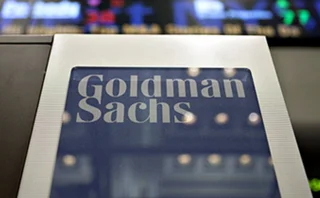
Crypto structured products come of age
After some growing pains, the space now offers the type of structures seen in TradFi equities markets
For the traditional wealth management client base, structured products have long ruled the roost. The mighty equity autocallable, in particular, has long been a favourite of investors, giving them a cushion of downside protection combined with upside exposure to single stocks or baskets.
Over the past year, though, the crypto industry has quietly been working on its own versions of structured products that are becoming more and more sophisticated as the months roll on.
These have largely existed in a corner of the crypto landscape known as decentralised finance (DeFi) – that is, unconnected to any centralised exchange such as Binance or FTX. Instead, the investor utilises smart contracts to conduct the investment strategy on their behalf.
While a centralised platform might block users from using derivatives depending on its jurisdiction’s regulatory status – for instance, UK retail users cannot trade crypto futures on most large, centralised venues – DeFi has no such restrictions. That means users can access sophisticated derivatives strategies that would otherwise be beyond their reach – for better or worse.
The original crypto structured products were housed in so-called DeFi options vaults (DOVs). Users deposit crypto anonymously into the DOVs – whether that be stablecoins like tether or USDC, or assets such as ethereum (ETH) or bitcoin – and the DOVs go out and run an investment strategy on behalf of the investors.
The original DOVs ran simple covered call or put selling strategies. The first and biggest protocol offering DOVs is Ribbon Finance, with $78 million in its DOVs as of November 4, according to aggregator site DefiLlama, down from a peak of more than $300 million in May – before the onset of the so-called crypto winter. Other larger protocols include Thetanuts and StakeDAO, which also offer similar products.
The ETH covered call DOV at Ribbon takes deposits in ETH and sells out-of-the-money one-week ETH calls at 10 delta to earn the premium, which amounts to around 0.25–0.45% a week. If the options finish in-the-money, the premium is lost and the rise in the underlying ETH asset is effectively capped. Investors are still exposed to the underlying ETH losing value, however.
The put selling vaults typically see the user deposit stablecoins into the DOV, which sells downside puts and collects a premium. These are a bit riskier, as there is no natural offset if the puts expire in-the-money.
The options are sold via auction at 9am UTC on a Friday. However, as the size and timing of the options selling is well known in advance, market-makers can anticipate the flow. Implied volatilities on weekly ETH options around the time of the auction are typically about four vols below the previous 24 hours, according to research from Paradigm.
According to their research, that equates to around 0.1% less in premiums, or 5.35% annually in missed gains. Market-makers buying the options, on the other hand, say they need to position themselves for these flows, which some say are responsible for roughly a quarter of the entire supply of crypto options volatility and run into billions of dollars of notionals every week at some market-makers.
This raised questions as to whether the DOVs were a victim of their own success and caused some to wonder whether further expansion was possible. Ribbon, for instance, looked at running more random, unannounced intra-week auctions, but this sparked concern among market-makers that they would be unable to handle the flow without sufficient notice. In its research note, Paradigm suggests pre-announcing but spreading out the auctions to mitigate the impact on implied volatility.
But despite these growing pains, the firms haven’t been put off and have instead looked to create newer, more sophisticated strategies.
Ribbon launched a principal-protected product in August, which earns yield from lending USDC deposits to market-makers such as Folkvang and Wintermute and uses a portion of the interest payments to buy weekly out-of-the-money barrier options at around 8% on the top and downside. It offers a base yield of 4% with the potential for yields of up to 13%, depending on whether the options finish in-the-money.
The question now is where crypto structured products can go next. Those in the know say the end game for firms like Ribbon is to offer the full range of private banking-type products, including autocallables.
Some suggest they could be a disrupter to the TradFi private banking market, but with a broader base given the lack of a minimum wealth requirement to invest. However, after the troubles in crypto earlier this year, the assets under management of the likes of Ribbon took a hit and have remained fairly stable since.
On the institutional side, plenty of firms are bullish in this space. The past year has seen a number of them spring up to service institutional clients looking for crypto structured investments without necessarily wanting to dip into DeFi themselves or in need of bespoke structuring solutions. These firms include OrBit Markets and Enhanced Digital Group, which were founded by former derivatives traders at large sell-side banks.
If institutional investors rediscover the interest in the space they showed before the crypto winter set in, who knows where it might lead?
Only users who have a paid subscription or are part of a corporate subscription are able to print or copy content.
To access these options, along with all other subscription benefits, please contact customer services - www.fx-markets.com/static/contact-us, or view our subscription options here: https://subscriptions.fx-markets.com/subscribe
You are currently unable to print this content. Please contact customer services - www.fx-markets.com/static/contact-us to find out more.
You are currently unable to copy this content. Please contact info@fx-markets.com to find out more.
Copyright Infopro Digital Limited. All rights reserved.
As outlined in our terms and conditions, https://www.infopro-digital.com/terms-and-conditions/subscriptions/ (point 2.4), printing is limited to a single copy.
If you would like to purchase additional rights please email info@fx-markets.com
Copyright Infopro Digital Limited. All rights reserved.
You may share this content using our article tools. As outlined in our terms and conditions, https://www.infopro-digital.com/terms-and-conditions/subscriptions/ (clause 2.4), an Authorised User may only make one copy of the materials for their own personal use. You must also comply with the restrictions in clause 2.5.
If you would like to purchase additional rights please email info@fx-markets.com
More on Trading
Goldman Sachs doubled FX trading revenues in 2024
Bumper Q4 powers bank to head of US dealer pack by foreign exchange revenue
EU firms fear dollar liquidity becoming tariff bargaining chip
Eurozone banks rely on dollars for 17% of funding; trade war escalation could affect access
Trump tariffs sent FX options traders on a wild ride
As US assets sold off, dealers found themselves on the front lines of a hedging scramble
FX liquidity ‘worse than Covid’ amid tariff volatility, dealers say
Available liquidity for single clips dropped to as low as $20 million ahead of tariff pause
TCA providers link FX counterparty selection with execution
Services from BestX and Tradefeedr aim to automate the pre-trade and execution process
Tariffs volatility prompts rush to re-hedge EUR/USD options books
Banks left scrambling to buy vol as spot surged beyond expectations
Dealers bullish on Bloomberg chat interface for FX markets
Service expanded its API offering to integrate broker chats into banks’ engines for cash FX pricing late last year
Corporates hamstrung in response to FX volatility
Restrictions around hedging programmes leave US firms struggling to adapt to dollar weakness








